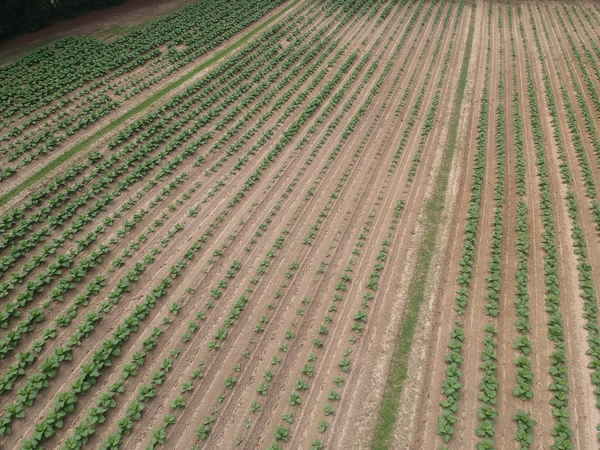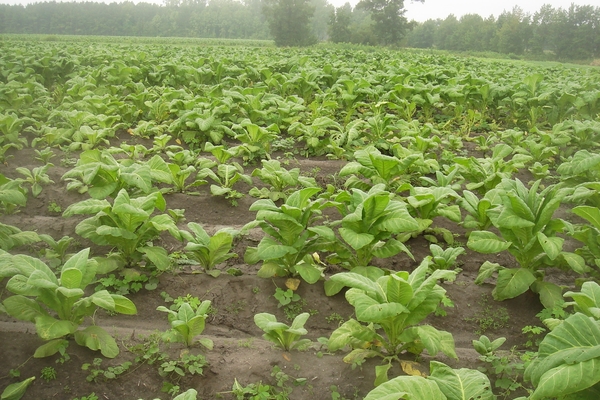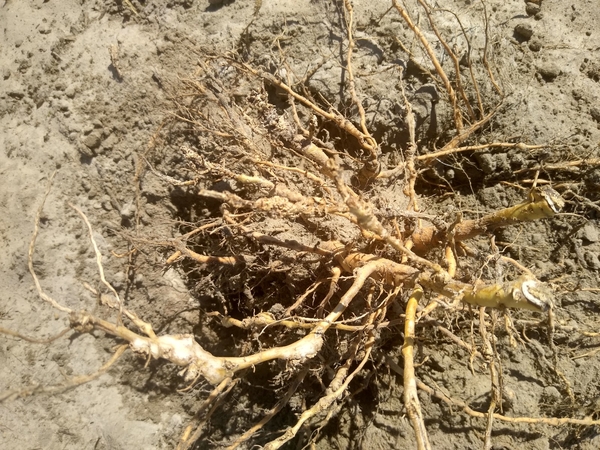Pathogen
Root-knot nematodes (Meloidogyne spp.) are microscopic roundworms that are widely distributed throughout North Carolina on many row and vegetable crops. Specific root-knot nematode species that affect tobacco include the southern root-knot (M. incognita), northern root-knot nematode (M. hapla), Javanese root-knot (M. javanica), and the more recently introduced guava root-knot nematode (M. enterolobii). Of these, the southern root-knot (M. incognita) is the most wide-spread root-knot nematode in North Carolina. The guava root-knot nematode is an invasive species that has been reported in Florida, Louisiana, North Carolina, South Carolina, and Georgia. Across the globe, other official reports of the guava root-knot nematode include tropical to sub-tropical areas in Asia (China and Vietnam), South and West Africa (Malawi, Senegal, Ivory Coast and Burkina Faso), Central and South America (Mexico and Brazil), and the Caribbean islands, including Cuba, Puerto Rico, Tobago, Trinidad, Guadeloupe, and Martinique.
Host Range
Root-knot nematodes have a very extensive range of hosts, including several field crops grown in rotation with tobacco in North Carolina such as cotton, soybean, sweetpotato, and corn. Additionally, many vegetable crops, potatoes, and numerous weed species are also host to root-knot nematodes. However, each specific species of root-knot nematode has an associated list of hosts, some of which overlap with other root-knot nematode species. These hosts are outlined in Table 1 below.
Nematode Life Cycle and Favorable Conditions for Disease
The life cycle of root-knot nematodes begins as an egg, goes through several successive juvenile stages, then reaches an adult stage. Eggs are produced in egg sacs at the root surface by female root-knot nematodes, which feed and survive fully inside the roots. The eggs survive in the soil until conditions are conducive for hatching. Infectious juvenile nematodes hatch from the eggs, move through the soil via water films, and invade nearby host roots. Once inside the host root, the juvenile root-knot nematodes will establish permanent feeding sites that will provide them sufficient nutrients for the rest of their life. The majority of the juveniles will become spherical-shaped adult females; a minor proportion will become adult males, which will leave the root and not feed. Adult female root-knot nematodes stimulate the root tissues at their feeding site to enlarge, producing the galls that are characteristic of infection by this nematode. Each female may lay hundreds of new eggs on the root surface, which then hatch in warm, moist soil to continue the life cycle.
The length of the life cycle depends on several factors, including soil temperature, soil moisture, and host plant suitability. under optimal conditions the life cycle takes approximately 25 days. Root-knot nematodes also require adequate soil moisture for egg hatching and movement through soil to host roots. Soil moisture conditions that are optimum for plant growth are also ideal for the development of root-knot nematodes.
Symptoms and Signs
Aboveground symptoms are frequently observed in “disease foci” or patches across the field, where the population density of nematodes is moderate to high (Figure 1). Plants in these patches may be chlorotic (yellowed), stunted, and wilted (Figure 2). Foliar symptoms may indicate secondary infections caused by root rotting pathogens like Fusarium wilt, Black Shank, or Granville Wilt following the root damage caused by root-knot nematode feeding. Foliar symptoms are more severe under drought conditions because nematodes are directly impacting the plants ability to uptake water and nutrients as well as increasing secondary pathogens.
Root-knot nematode infestations can often be identified in the field by the presence of galls, knots, or bumps on the root system of tobacco plants. These root galls are localized swelling of root tissues initiated through feeding of the nematode inside the root (Figure 3 & Figure 4). Root galls from advanced infections may coalesce so that the root appears swollen along the entire length. Roots may also display symptoms of secondary infections.
The symptoms caused by different species of root-knot nematode are similar, and it is possible to have multiple species infecting one field. The guava root-knot nematode (M. enterolobii) is considered more aggressive than other root-knot species found in North Carolina, and may cause significant damage to tobacco roots and can increase in population rapidly in a relatively short period of time. Galling caused by M. enterolobii may be larger and more severe, though not quantifiably different, than other root knot species found in North Carolina and it is not possible to differentiate species of root-knot nematodes based on galling symptoms alone. Due to differences in managing M. enterolobii and other species of root-knot nematode, identification of root-knot nematode species is important. Differentiating between species requires a molecular-based PCR assay because the nematode species are morphologically very similar.
Identification
If a tobacco crop is suspected to be impacted by root-knot nematodes, plants should be dug up, taking care to preserve the integrity of the root system as possible. Roots should be washed gently in a bucket of water or under running water to remove soil. Visually inspect root, looking for the presence of root galls (Figure 3 & Figure 4), which indicate infection of the tobacco plant by root-knot nematodes. Although the presence of root galls is sufficient to diagnose root-knot nematodes in tobacco, root galling symptoms alone will not indicate the level of nematode pressure (nematode population counts) in the field, nor indicate what specific species of root-knot nematode is present. Diagnosis can be confirmed through assessment of soil and root samples for the presence of root-knot nematodes by a plant disease diagnostic laboratory or nematode assay lab. Soil samples for nematode assay services may be submitted to the North Carolina Department of Agriculture & Consumer Services (NCDA&CS), Agronomic Services, Nematode Assay Laboratory, 4300 Reedy Creek Road, Raleigh, NC 27607.
Nematode populations vary throughout a field, so multiple areas of the field should be sampled to provide an accurate evaluation of the entire field. Using a soil probe or hand trowel, collect 20 to 30 soil cores from a 5-acre block, at a depth of 6-8 inches, along either a grid-like or a zig-zag pattern across the field. Combine the soil cores in a clean plastic bucket and remove a smaller subsample from this larger sample to submit to the Nematode Assay Laboratory. Detailed sampling instructions and sample submission forms can be found at the NCDA&CS Nematode Assay Laboratory sampling guidelines.
The standard nematode soil assay cannot differentiate between specific root-knot nematode species, due to the highly similar appearance of these nematode species under the microscope. Root-knot nematode species identification can be obtained through a molecular assay at a diagnostic lab. This molecular diagnosis must be requested when submitting a sample and usually requires an additional fee. When requesting a molecular assay, it is helpful to include roots with distinct root galls at the time of sample submission as well as an accurate crop history, information about fertility, herbicides, and cultural practices to aid in diagnosis.
General Management
Managing root-knot nematodes can be difficult due to their broad host range. Routine soil sampling for nematode analysis is important to better understand if root-knot nematodes are present in the field and if their population densities pose a risk to the tobacco crop. Although soil samples for nematode analysis can be collected anytime in which the soil is not frozen and in good condition, sampling is best conducted in the fall, around harvest time, prior to Thanksgiving when nematode numbers are at their highest. It is valuable to know what the nematode pressures are in a given field to select the proper management tools.
Exclusion and Sanitation
Root-knot nematodes can be moved in infested soil via equipment, vehicles, tools, or shoes that have entered the field. Equipment from nematode-infested fields should be sanitized before moving to unaffected fields. Workers should also sanitize shoes after working in nematode-infested fields. Working in fields with known high populations of root-knot nematode last will reduce time and effort needed for sanitation of equipment.
Resistant Varieties
Host resistance is one of the most cost-effective management tools for managing root-knot nematodes. Tobacco varieties are available with resistance (conferenced by a gene called Rk) to races 1 and 3 of the southern root-knot nematode (M. incognita) and race 1 of the peanut root-knot nematode (M. arenaria), which are listed in the Flue-Cured Tobacco Guide. Currently, nearly all the commercially available tobacco cultivars sold for growing in North Carolina and South Carolina possess this resistance. However, no commercial tobacco varieties with resistance to M. enterolobii are available at this time.
Crop Rotation
Crop rotation may decrease the nematode populations when a non-host crop is used as a rotation. Non-host and poor-host crops for root-knot nematodes, such as southern and guava root knot nematodes include sorghum, grasses, grain, alfalfa, peanuts, and resistant varieties of soybean and corn (Table 1).
Table 1. List of host and non-host crops of root-knot nematodes reported in North Carolina
| Root-knot nematode species | Does this root-knot species infect tobacco? | Other Host Crops | Non-host or poor-host crops |
|---|---|---|---|
| Southern root-knot nematode (Meloidogyne incognita) | Yes1 | Soybean, cotton, corn, small grains (wheat, oats, rye), tomato, watermelon, sweetpotato, potato, other vegetables | Peanut, sesame, sunn hemp |
| Peanut root-knot nematode (Meloidogyne arenaria) | Yes1 | Peanut, soybean, corn, small grains, sweetpotato, tomato, watermelon, sweetpotato | Cotton, strawberry, sorghum-sudangrass |
| Javanese root-knot nematode (Meloidogyne javanica) | Yes | Soybean, cotton, corn, small grains, sorghum, tomato, watermelon, potatoes | Peanut, pepper, sunn hemp |
| Northern root-knot nematode (Meloidogyne hapla) | Yes | Soybean, peanut, sweetpotato, tomato, potato, other vegetables | Cotton, corn, watermelon, small grains, sorghum-sudangrass |
| Guava root-knot nematode (Meloidogyne enterolobii) | Yes | Soybean, cotton, sweetpotato, tomato, potato, other vegetables | Corn, peanut, small grains, sorghum-sudangrass |
1Genetic host resistance is available in some tobacco varieties to this species. Please see “Resistant Varieties” section. ↲
Conventional Chemical Management
Chemical management options help to reduce populations of root-knot nematodes within the field and prevent infection of host plants. The products in Table 2 below have a label for use in tobacco, as of 2023. For annually updated chemical management tools, please consult the North Carolina Agricultural Chemical Manual.
Table 2. Chemical management options for suppression of root-knot nematodes in tobacco. Table may not represent a complete list of all products registered for suppression of nematodes in tobacco in North Carolina, and inclusion of the products in the list does not endorse efficacy. Please refer to product labels for application methods, regulations, and compliances.
| Nematicide1 | Amount/acre | Precautions/Remarks | Efficacy against M. incognita | Efficacy against M. enterolobii |
|---|---|---|---|---|
| Fumigants 1,3-dichloropropene (Telone II) |
6.0 gal | Apply fumigants and multi-purpose fumigants at a final depth of 12 to 14 inches. See label for precautions and application requirements. | Excellent | Good |
| 1,3-dichloropropene + chloropicrin (Telone C-17; Telone C-35; Pic-Clor60;) (In Line) | 12.0 gal | Fair to Good | Poor to Fair | |
| sodium methyldithiocarbamate (metam sodium; Vapam HL; Metam CLR 42%) | 37.5 to 70 gallons | Apply when soil temperature is between 35ºF and 90ºF and soil is moist but not wet. See label for precautions and application requirements. | Fair | Fair |
| Contact Nematicides2 fluensulfone (Nimitz) | 3.5 to 7 pt | Adequate watering in or rain after application is needed for maximum product efficacy. See label for precautions and application requirements. | Fair to Good | Poor to Fair |
| fluopyram (Velum Prime) | 6.5 to 6.85 fl oz | Transplant water application in combination with mechanical planting. See label for precautions and application requirements. | Fair to Good | Poor to Fair |
1See label for proper PPE, rates, and restrictions associated with each chemical. Chemical treatments listed are not exhaustive, and several seed treatment and in-furrow chemical options are available from different chemical companies. ↲
2Contact nematicides may not be effective in situations with high nematode populations. Assess nematode populations in the fall prior to use of nematicides for effective selection of chemistries to control populations. ↲
Useful Resources
-
The NCDA&CS Nematode Assay Lab provides soil detection and diagnostics.
-
The American Phytopathological Society information page for Root Knot Nematode has more detailed information about root knot nematodes.
-
The North Carolina Agricultural Chemicals Manual provides an up-to-date list of chemicals available for control of nematodes and other diseases and pests.
-
The NC State University Plant Disease and Insect Clinic provides diagnostics and control recommendations.
-
The Extension Plant Pathology Portal provides information on crop disease management.
-
The Flue-Cured Tobacco Guide has descriptions of diseases and controls, updated annually.
Publication date: Oct. 8, 2018
Reviewed/Revised: Aug. 23, 2023
N.C. Cooperative Extension prohibits discrimination and harassment regardless of age, color, disability, family and marital status, gender identity, national origin, political beliefs, race, religion, sex (including pregnancy), sexual orientation and veteran status.
NC Cooperative Extension prohíbe la discriminación por raza, color, nacionalidad, edad, sexo (incluyendo el embarazo), discapacidad, religión, orientación sexual, identidad de género, información genética, afiliación política, y estatus de veteran.
Recommendations for the use of agricultural chemicals are included in this publication as a convenience to the reader. The use of brand names and any mention or listing of commercial products or services in this publication does not imply endorsement by NC State University or N.C. A&T State University nor discrimination against similar products or services not mentioned. Individuals who use agricultural chemicals are responsible for ensuring that the intended use complies with current regulations and conforms to the product label. Be sure to obtain current information about usage regulations and examine a current product label before applying any chemical. For assistance, contact your local N.C. Cooperative Extension county center.
N.C. Cooperative Extension prohibits discrimination and harassment regardless of age, color, disability, family and marital status, gender identity, national origin, political beliefs, race, religion, sex (including pregnancy), sexual orientation and veteran status.




